REFILL@LILLE: Policy Design Labs and URBACT exchange networks
Edited on
05 September 2019How civil servants from Lille Metropole benefited from the experience of URBACT REFILL network to shape a roadmap to set their temporary use policy.
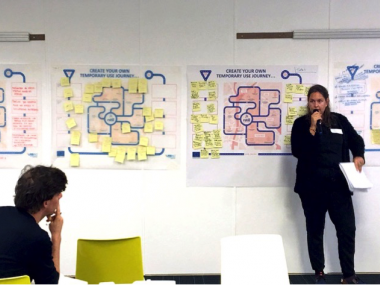
The first part of this article (see REFILL@LILLE, PART 1) showed the policy design lab approach of the Metropole of Lille (FR) to kick-off support for a Working Group on Temporary Use. The second part focuses on how civil servants from Lille Metropole benefited from the experience of URBACT REFILL network.
Learning from inspirational practices
The field experience of settling a “temporary public policy design lab" only scratches the surface of the problem of more than 5,000 vacant spaces on the territory and the appetite local stakeholders have for temporary use. But, immersion is worth 1,000 words: the Metropole civil servants do not usually address a new project in this way! By acquiring a significant experience of the problem, they are ready to explore and analyse other temporary use experiences in France and Europe. A wealth of case studies awaits from sixty local and national examples, as well and many European references conducted across Europe for three years within URBACT "REFILL The City" including 10 European cities: Ghent (BE), Athens (EL), Amersfoort (NL), Bremen (DE), Cluj (RO), Helsinki (FI), Nantes (FR), Ostrava (CZ), Poznan (PL) and Riga (LV).
A temporary roadmap
Building on the Roadmap to temporary use tool (from the toolbox produced and made available by the REFILL network) helps the establishment of a practice of temporary use in cities. This roadmap represents the “city of REFILL”: a virtual city that would combine the best practices of the 10 participating cities.
Different neighbourhoods represent the different major steps of the establishment of a temporary use practice: a "zone of cultural, social, entrepreneurial" candidates for temporary use; an "administrative district" dealing with legal, technical and safety; a "district with support services” to temporary use; etc.
A circular road connects each of these neighbourhoods, suggesting about fifteen milestones as "mapping the vacant spaces":
- "Analysing the supply and demand";
- "Building the political support";
- "Developing a new temporary use value creation model"; etc.
Unlike a framed method, the REFILL Roadmap is like a tourist map suggesting different possible itineraries each city must choose, starting with the most pertinent actions, organising its progress in the local context and creating its own route.
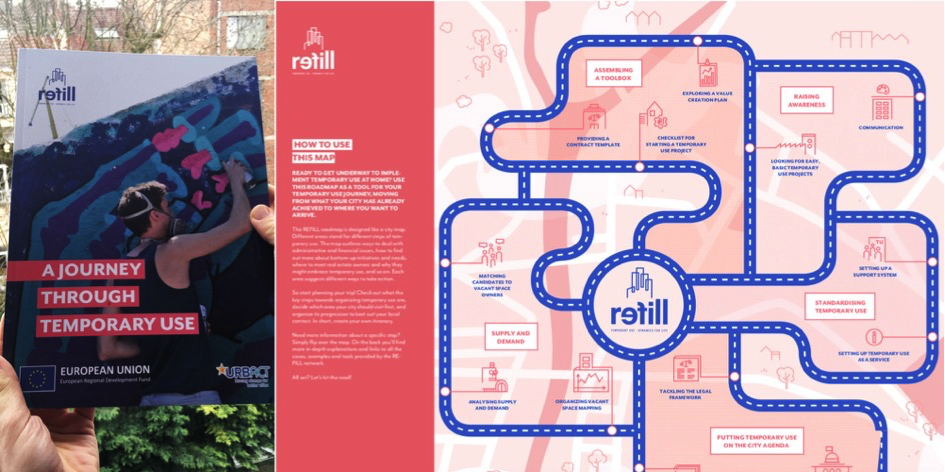
The forming lab ambassadors discussed the implications of each example, gathering in small groups to fill in an analytical framework. After the field immersion, the lab consolidated and enriched its understanding of temporary use.
A pitch presenting a first rational of temporary use applied to the Metropole supported by a series of examples was recorded in the form of a short video. The film raised awareness about the many vacant spaces, the costs incurred for the public authority, and showcased temporary use as an opportunity with potential to host social, cultural, entrepreneurial initiatives - bringing people together, revitalising neighbourhoods, experimenting urban development projects and so on.
Sparking political attention
Thanks to experience and research, the Metropole forming lab had got a good idea of the challenges and opportunities for temporary use public service, putting together a kind of "service desk" of knowledge open to all. To create a solid launching pad for the future service, the Metropole required a large-scale demonstration project, drafting and accelerating the service and likely to convince at political level.
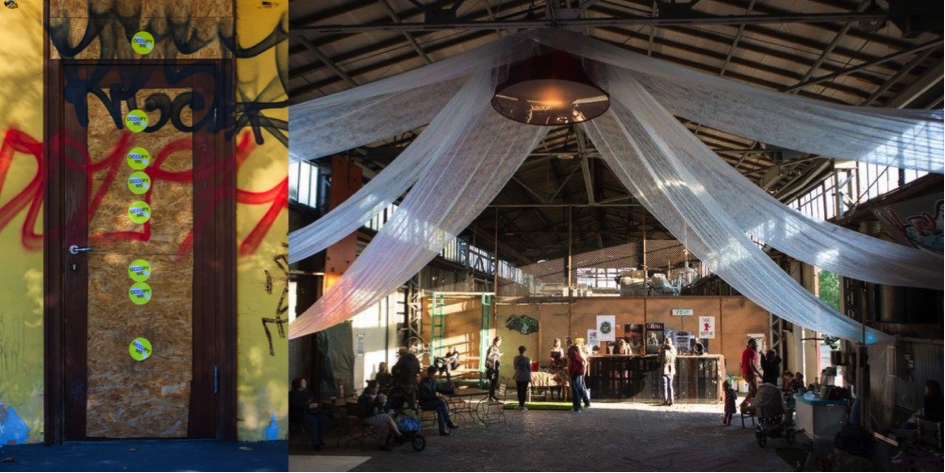
Inspiration then came from the city of Riga, REFILL network partner. Elected Capital of Culture in 2014, the city was experiencing a strong economic crisis and did not have the necessary infrastructure to host such an event nor the means to build them. The city made a collaborative agreement with a group of urban activists, squatters and actors of the cultural scene taken via the association Free Riga. The plan? To start a practice of temporary using vacant spaces to host the programming of its Capital of Culture! The urgency to find spaces to showcase the vibrant Latvian art scene helped to overcome the political cautiousness and set a precedent on which to build for all stakeholders.
The European Metropole of Lille will be the World Design Capital in 2020. The Metropole’s application was selected because it offered an ambitious territorial transformation through design, based on a call for innovation projects by the design of a set of social themes and particularly the emergence of design applied to public policy.
Although not comparable in all respects to the context of Riga in 2014, Lille Design World Capital 2020 seems to be a potential "launching pad" to install the practice of temporary use in the territory. More than 450 Proofs of Concept (POC) are announced in the territory for 2020. The POC is a key step in the design process allowing a light experiment to demonstrate viability of a concept before further developing the project.
The Metropole lab and the Working Group for Temporary Use have taken up the REFILL toolbox and co-constructed their own route towards the implementation of temporary use.
- First, the creation of a series of temporary use spaces during the Lille Design World Capital 2020. To do this, the ambassadors of the forming lab and the Property department identified a first group of 20 potential spaces, visited and documented the most promising and put together a first online catalogue of options. In parallel, they explored contracts, which services to provide and how to assess the proof of concepts of temporary use during 2020.
- Secondly, (after an assessment a year in) a policy of temporary use at the Metropole of Lille is to be established. This step includes the registration of "temporary use" in the territorial development and patrimonial valuation strategy of the Metropole, completing the online catalogue of vacant spaces and the establishment of a mediation service between supply and demand (technical and legal tools, financial support, etc.) internal or outsourced to a third party.

Conclusions
This experience allows us to make some assumptions of mutual enrichment between the URBACT approach (networks of towns sharing at European level on a specific challenge in terms of public policy creating an action plan) and, secondly, the approach of co-construction a public policy design lab (based on an innovative action-training process based on pilot projects).
The capitalised experience of 10 cities over a period of 3 years from REFILL network has accelerated the process of reflection of our Working Group for Temporary Use.
The organisation of the network deliverables in the form of a modular toolbox, together with a wide range of case studies (all articulated in the form of an open roadmap) was immediately actionable by a third city. Mediation transfer by an actor involved in both REFILL and the Metropole’s lab is a facilitating factor.
The existence of a public policies design lab in the Metropole’s administration helped seize the REFILL network’s experience faster and more efficiently.
The lab’s ability to partially overcome the slow decision-making and reporting processes and at least initiate a first experiment extends the co-construction process to stakeholders, making it immediately actionable.
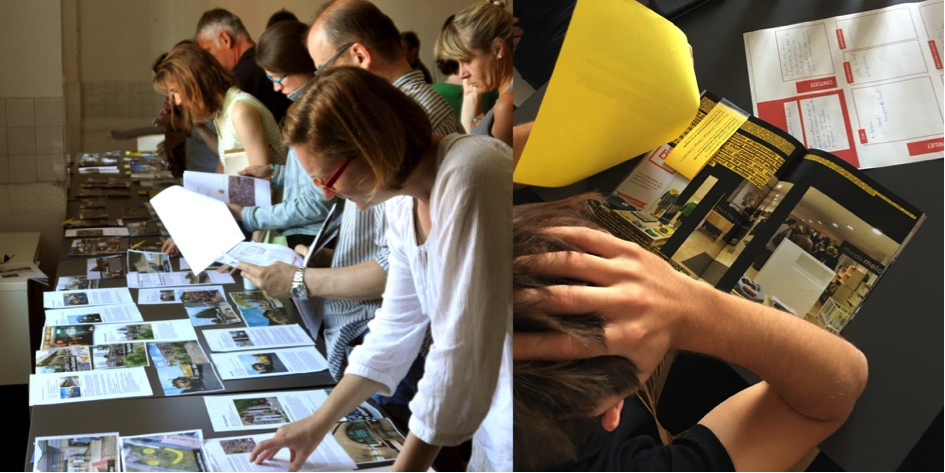
The public policy design lab and URBACT methods have an integrated approach in common, as well as the involvement of an ecosystem of stakeholders committed to co-design and public policy programming. The lab approach adds field experimentation, a key step in the design process to simulate and test each action of an action plan before its deployment on the ground. Its benefit is on the one hand, to test and improve each action and on the other hand to involve the actors and trigger its implementation.
The exchanges about a wide range of "inspiring cases" collected through REFILL helped initiate the strategic conversation among stakeholders in Lille and identify what they consider a good practice for their situation and seize an opportunity such as the Lille Design World Capital 2020.
The examples of Ghent and Riga, even if they are from different socio-cultural contexts, comfort the actors in the idea that if it is not a given, it's possible since others have already done it.
Finally, the partnership with the European Metropole of Lille proves the usefulness of lessons capitalised by an URBACT network such as REFILL. It validates the methodology and tools developed for the workshop: “Make your own path to the temporary use” at the URBACT Festival in Lisbon in September 2018. It also heralds the arrival other REFILL development processes, like the one initiated with the City of Brussels and Brussels at the end of 2018.
Know more about reusing vacant spaces on Remakingthecity.urbact.eu!
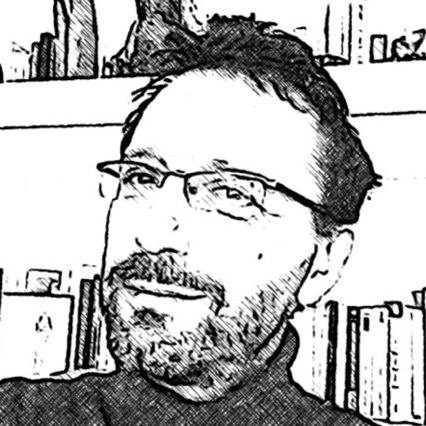 Submitted by François Jégou on
Submitted by François Jégou on




